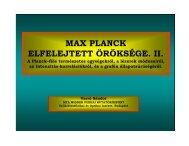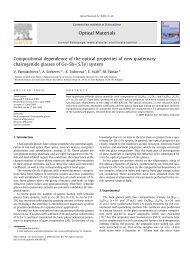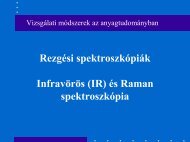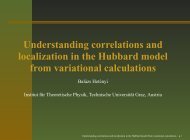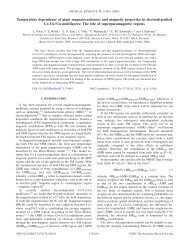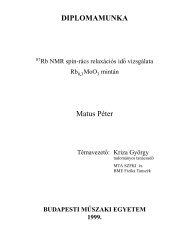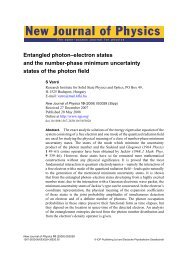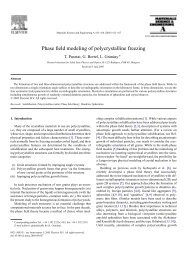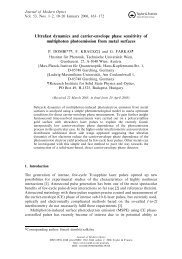ANNUAL REPORT - MTA SzFKI
ANNUAL REPORT - MTA SzFKI
ANNUAL REPORT - MTA SzFKI
You also want an ePaper? Increase the reach of your titles
YUMPU automatically turns print PDFs into web optimized ePapers that Google loves.
K. NEUTRON SCATTERING<br />
L. Pusztai, M. Fábián # , P. Jóvári, I. Harsányi, L. Kőszegi, Gy. Mészáros, V. Mile # , Sz.<br />
Pothoczki # , E. Sváb, L. Temleitner<br />
Liquids. — Neutron and X-ray diffraction results obtained for liquid carbon dioxide, CO 2 ,<br />
have been modelled by means of the reverse Monte Carlo method. Partial pair correlation<br />
functions, centre–centre pair correlation functions and relative orientations of molecular<br />
axes as a function of distances between molecular centres have been calculated from the<br />
models. It was found that well defined orientational correlations exist in the liquid state.<br />
Close to the critical point, these correlations seem to disappear, but further away from the<br />
critical point, in the high density supercritical state, they reappear. Using large particle<br />
configurations, the density fluctuations close to the critical point could be visualized, as<br />
demonstrated by Figure 1.<br />
(a)<br />
18<br />
g Si-O<br />
(r)<br />
12<br />
6<br />
Si - O<br />
(b)<br />
6<br />
4<br />
2<br />
g O-O<br />
(r)<br />
O-O<br />
(c)<br />
6<br />
g Si-Si<br />
(r)<br />
4<br />
2<br />
Si - Si<br />
0<br />
0 1 2 3 4 5 6<br />
r(Å)<br />
0<br />
1 2 3 4 5 6<br />
r(Å)<br />
0<br />
2 3 4 5 6<br />
r(Å)<br />
g Na-O<br />
(r)<br />
(d)<br />
3 Na - O<br />
2<br />
1<br />
0<br />
1 2 3 4 5 6<br />
The coherent static structure factor of water has been investigated by polarized neutron<br />
diffraction. Polarization analysis allows us to separate the huge incoherent scattering<br />
background from hydrogen and to obtain high quality data of the coherent scattering from<br />
four different mixtures of liquid H 2 O and D 2 O. Consistency with existing partial radial<br />
distribution functions, derived without the application of polarized neutrons, was checked<br />
by incorporating them into our reverse Monte Carlo calculations. It appeared that the<br />
partials from the literature are not entirely consistent with our new polarised neutron data.<br />
Reverse Monte Carlo calculations have been carried out to model the structure of aqueous<br />
RbCl solutions, as a function of salt concentration. Neutron and X-ray diffraction data<br />
were combined with various constraints concerning the coordination of chloride anions. It<br />
could be established that increasing ionic concentration causes increasing distortions to the<br />
hydrogen bonded network of water molecules—that is, RbCl is a ‘structure breaker’,<br />
although to a smaller extent than, for instance, LiCl. For the Rb cations a quite well<br />
# Ph.D. student<br />
r(Å)<br />
(e)<br />
3<br />
g Si-Na<br />
(r)<br />
2<br />
1<br />
Si - Na<br />
0<br />
2 3 4 5 6<br />
r(Å)<br />
(f)<br />
4<br />
3<br />
2<br />
1<br />
Na - Na<br />
0<br />
2 3 4 5 6<br />
Fig. 1. Two-dimensional projections of atomic density maps for gaseous (g), near-critical and high density<br />
supercritical fluid (sc) and normal liquid (l) CO 2 . The pictures were taken on 3–4 Å thick layers<br />
(depending on the edge length of the simulation cell), containing roughly 240 molecules.<br />
g Na-Na<br />
(r)<br />
r(Å)<br />
51



